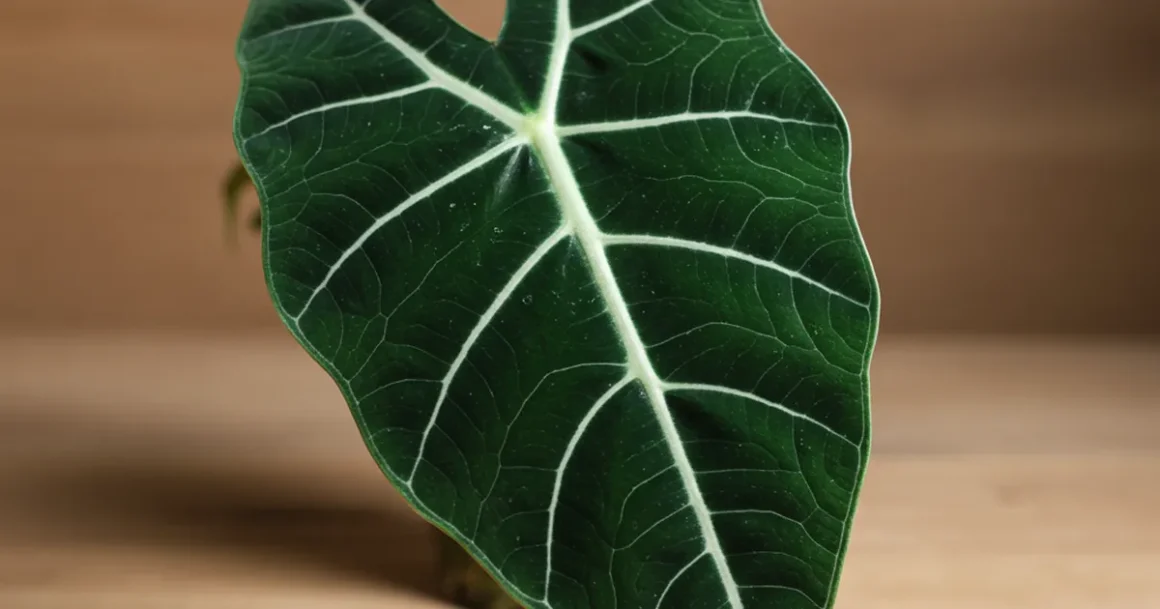Introduction:
Alocasia Black Velvet (Alocasia reginula) is a fantastic indoor plant that can create a significant impact even in limited spaces. Most plants in the Alocasia genus are recognized for their large, tropical-looking, heart or arrow-shaped leaves, which have earned them the common name “Elephant ears“. Unlike many others in the genus, Black Velvet grows slowly and remains relatively small. Sometimes known as a jewel alocasia due to its diminutive size.
While this plant is not grown for its flowers, as it seldom blooms and its white inflorescence is quite unobtrusive, its most prominent feature is the striking silver veins on the thick, textured, dark green (almost black) foliage. Alocasia Black Velvet requires specific attention as it might go dormant or shed its leaves without proper care. Thriving in high humidity, it is best suited for a humid, sunny bathroom.
| Common Name |
Alocasia Black Velvet, Black Velvet Elephant Ear |
| Botanical Name |
Alocasia reginula A.Hay |
| Family |
Araceae |
| Plant Type |
Herbaceous, Perennial |
| Mature Size |
Up to 1.5 ft. tall |
| Sun Exposure |
Partial |
| Soil Type |
Well-drained |
| Soil pH |
Acid, Neutral |
| Bloom Time |
Very occasional |
| Flower Color |
White |
| Hardiness Zones |
10+ (USDA) |
| Native Area |
Southeast Asia |
| Toxicity |
Toxic to people, toxic to pets |
Trimming
This plant does not have strict trimming requirements. However, even on the most robust mature plants, it is necessary to prune away dead or dying leaves to allow new ones to grow. This practice enhances the efficient flow of nutrients to the new leaves.
Alocasia Black Velvet seldom produces flowers, and if they do bloom, the flowers are not particularly remarkable. If you notice any flowers appearing, removing them can help channel the plant’s energy towards its main feature—the foliage.
Alocasia Black Velvet Propagation
Propagating Alocasia Black Velvet through stem cuttings or leaves is not feasible, and seed germination can be challenging and slow. However, these plants spread through rhizomes, which are underground horizontal stems. The rhizomes generate new upward shoots, leading to a clumping growth habit. You can propagate Alocasia Black Velvet by dividing clumps or potting rhizome cuttings from mature plants with relative ease:
Wait until spring once the plant emerges from dormancy
Wear gloves to protect your skin from potential irritation
Remove the plant from its pot and carefully shake off the soil around the roots to expose the rhizomes
Using a clean knife, cut healthy-looking rhizome offsets from the central stem
Plant the cuttings in a moist, well-draining potting mix and keep them in a warm, humid environment
Allow time for roots to develop and establish, typically taking a few weeks for new growth to emerge
These plants also produce individual corms, which are small underground bulb-like stems that give rise to new plants. Corms do not propagate well in soil due to insufficient humidity. However, you can propagate these Alocasia corms by placing them in shallow water and covering them to maintain adequate humidity levels.
A Guide to Potting and Repotting Alocasia Black Velvet
Alocasia Black Velvet prefers being slightly rootbound. Due to its slow growth, you will probably only need to repot it every few years or when dividing rhizomes.
Winter Care
As Alocasia Black Velvet is a type of houseplant, there is no requirement for overwintering it. Nonetheless, in regions with colder climates, it is essential to maintain a temperature above 60 degrees Fahrenheit and offer additional warmth to the plant.
Common Insects and Plant Illnesses
Alocasia Black Velvet may be affected by spider mite infestations. These tiny creatures flourish in arid conditions, so ensuring adequate humidity levels can prevent the pests, benefiting your moisture-loving Alocasia plant.
While these plants are typically resistant to diseases, they may be susceptible to root rot when subjected to excessive watering and insufficient soil drainage.
Issues Typically Encountered with Alocasia Black Velvet
Alocasia Black Velvet thrives in warm, humid environments and rewards with stunning foliage if proper care is given, especially in terms of watering. To ensure your plant flourishes, be on the lookout for the following concerns:
Leaves Curling
Curling leaves are often seen in plants exposed to direct sunlight. If you notice leaves curling at the edges, consider relocating the plant to an area with more filtered light. Also, be cautious of letting the plant dry out excessively.
Yellowing Leaves
Yellowing leaves indicate that the Alocasia Black Velvet is receiving too much water and requires a less frequent watering schedule or a better-draining potting mix.
Brown Tips
While overwatering is a common issue with these plants, insufficient water can lead to brown leaf tips as an early symptom. Additionally, excessive fertilizer application can result in burnt leaf tips.
FAQ
How fast does Alocasia Black Velvet grow?
These miniature gems have a slower growth rate compared to larger Alocasia varieties. It may take two to five years for them to reach maturity, with a maximum height of around 18 inches even when fully developed.
Is Alocasia Black Velvet rare?
Originating from Borneo, this plant is seldom found in its natural habitat. Due to its increasing popularity, more specialized nurseries are now cultivating Alocasia Black Velvet for commercial purposes. Nonetheless, it remains relatively uncommon to come across this plant in regular garden stores.
What’s the difference between Alocasia Black

